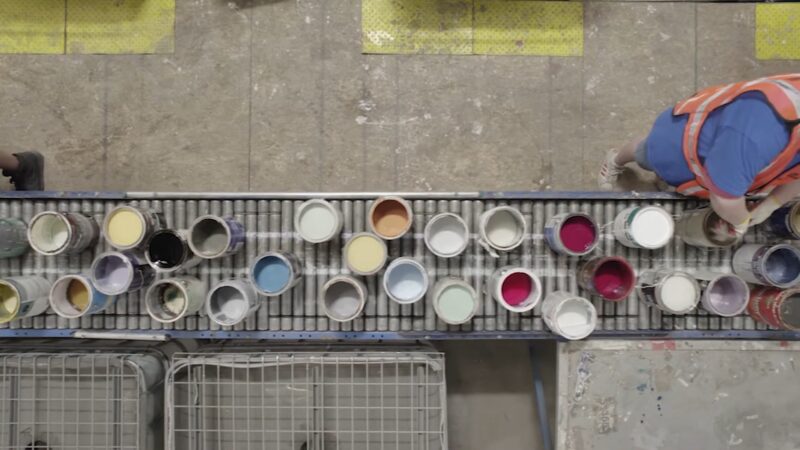Painting your home can be a fun and rewarding project, but what do you do with the leftover paint when you’re done? You might think that throwing it away in the trash or pouring it down the drain is the easiest solution, but that’s actually illegal and harmful to the environment.
Paint is considered a hazardous waste in Michigan, and it needs to be disposed of properly to prevent pollution and health risks. In this blog post, I’ll show you how to recycle or donate your unused paint or find a drop-off site or collection event near you.
Follow these steps to get rid of your paint safely and responsibly.
Step 1: Check the Condition of Your Paint

Before you decide what to do with your paint, you need to check if it’s still usable or not. Usable paint is liquid, has no lumps or skin, and has not frozen or been exposed to extreme temperatures.
Unusable paint is solid, chunky, moldy, or has a bad odor. You can also test your paint by stirring it well and brushing a small amount on a piece of cardboard. If it looks and smells normal, it’s usable.
If it’s clumpy, separated, or foul-smelling, it’s unusable.
Step 2: Recycle or Donate Your Usable Paint
If your paint is still in good condition, you have two options: recycle it or donate it. Recycling your paint means that it will be processed and turned into new paint or other products.
Donating your paint means that you will give it to someone else who can use it for their own projects. Here are some ways to recycle or donate your paint:
Use a Paint Recycling Program

Various paint producers and retailers have established programs for recycling paint, where they accept leftover paint from consumers and repurpose it into new batches. These programs are operational in numerous states, including Michigan.
To locate a nearby drop-off point, you can use an online site locator or contact a dedicated helpline. These programs typically accept a wide range of paint, stain, and varnish products, provided they are in their original containers with intact labels and lids.
There is no fee for depositing your paint, and there are no limits on the quantity you can bring.
Donate to A Local Organization
Instead of letting your leftover paint languish in the garage, consider donating it to a friend, neighbor, school, or charitable organization that can put it to good use. Social media platforms like Facebook and neighborhood forums offer excellent avenues to connect with potential recipients.
Additionally, websites like Freecycle and Craigslist can help you find individuals or groups in your area who are in need of paint. When reaching out to potential recipients, clearly communicate the type, color, and quantity of paint you have available.
Arrange a safe and convenient method for delivering or picking up the paint. Organizations that often accept paint donations include Habitat for Humanity, Goodwill, the Salvation Army, and local churches, shelters, and community centers.
Use It for Another Project

Rather than letting leftover paint go to waste, consider reimagining its purpose around your home. Utilize it to refresh your walls, transform furniture, or embark on artistic endeavors.
Experiment by combining colors to produce unique hues or incorporate additives to alter the paint’s texture or finish. Unleash your creativity and enjoy the process!
Step 3: Dispose of Your Unusable Paint
If your paint is no longer usable, you need to dispose of it properly. You cannot throw it away in the trash or pour it down the drain, as this can cause environmental damage and health hazards.
Here are a few methods for properly disposing of your paint that cannot be recycled or donated, as it may not function properly and could potentially damage someone else’s work.
Use a Hazardous Waste Collection Program

The most effective method for disposing of unusable paint is to utilize a hazardous waste collection service. These services, often managed by local authorities or specialized private companies, are equipped to safely and legally handle and dispose of hazardous materials, including paint and other household chemicals.
To find a service in your area, visit the website of the Michigan Department of Environment, Great Lakes, and Energy (EGLE) and select your county. This will provide you with a list of contacts and locations for paint drop-off or pick-up services.
Some of these programs might be free, while others could charge a fee or require prior scheduling. Ensure you adhere to the specific instructions and guidelines of the chosen service, and bring your paint in its original, labeled container with a lid.
Dry out Your Paint and Throw It Away
If a hazardous waste collection program is unavailable nearby, or if you have a minimal amount of paint, consider drying the paint before disposal. This approach is less recommended due to potential mess, time consumption, and risks of leakage or spillage.
To dry the paint, you can leave the lid off for natural evaporation, or mix in absorbent materials like cat litter, sawdust, or sand to expedite the process. Alternatively, purchase a paint hardener from a hardware store and follow the instructions provided.
Once the paint is completely dry and solidified, place it in a plastic bag for disposal in the trash. Note that this method is not suitable for oil-based paints, as they do not dry out in the same way and can be a fire hazard.
Step 4: Clean up And Store Your Paint Supplies
Once you have completed recycling, donating, or disposing of your paint, it is important to tidy up and store your paint supplies appropriately. Here are a few suggestions to assist you with this process.
Clean Your Brushes and Rollers
To clean your brushes and rollers, you need to rinse them with water if you use latex paint, or with mineral spirits if you use oil-based paint. You can also use a brush comb or a roller cleaner tool to remove any excess paint.
Then, you need to dry them with a paper towel or a cloth and store them in a plastic bag or a container. You can also wrap them in aluminum foil or plastic wrap and put them in the freezer if you plan to use them again soon.
Clean Your Trays and Buckets
To clean your trays and buckets, you need to scrape off any excess paint and rinse them with water or mineral spirits, depending on the type of paint you use. You can also use a paint scraper or a putty knife to remove any dried paint.
Then, you need to dry them with a paper towel or a cloth and store them in a dry place. You can also reuse them for another project or recycle them if they are made of metal or plastic.
Store Your Leftover Paint

To keep leftover paint for future use, proper storage is key to prevent it from drying out or spoiling. Follow these simple steps:
- Seal the Container: Ensure the container is airtight to stop the paint from drying or skinning over. Use a rubber mallet or hammer to tightly close the lid, or employ plastic wrap or a bag for an extra seal. Placing plastic wrap or wax paper between the lid can help prevent rust.
- Label the Container: Clearly mark the container with the paint’s type, color, brand, and date. Note the room or project where it was used and the remaining quantity for easy future identification.
- Store Properly: Keep the container in a cool, dry, and dark area, away from extreme temperatures, sunlight, and moisture. Ideal storage locations include a basement, closet, garage, or shed, ensuring the temperature remains stable and doesn’t exceed 100°F or drop below freezing. Storing the container upside down can also enhance the seal and reduce rusting.
FAQ
Can I mix different types of paint together for recycling?
It’s not recommended to mix different types of paint, such as oil-based and latex, as they have different recycling processes. Keep them separate to ensure proper recycling.
How long can I store leftover paint?
Properly stored paint can last up to 10 years. Ensure it’s sealed tightly and stored in a cool, dry place to maximize its shelf life.
Is it safe to recycle paint cans with rust?
Rusty paint cans might be rejected by some recycling programs. It’s best to transfer the paint to a new, clean container if the original is rusty.
Can I donate half-used cans of paint?
Yes, many organizations accept partially used cans of paint, as long as the paint is still in good condition and properly labeled.
How do I know if a paint recycling program accepts my type of paint?
Check the program’s guidelines online or contact them directly. Most accept a variety of paints, but there may be restrictions on certain types.
What should I do if there’s no paint recycling program in my area?
If local recycling options are unavailable, consider donating the paint or using a mail-in recycling service. Alternatively, use the drying-out method for safe disposal.
Final Words
I hope this blog post has helped you learn how to dispose of unused paint in Michigan. By following these steps, you can get rid of your paint safely and responsibly, and help protect the environment and your health.
You can also recycle or donate your paint to someone who can use it, or use it for another project yourself. Remember to always check the condition of your paint, and use a hazardous waste collection program or a paint recycling program whenever possible.
And don’t forget to clean up and store your paint supplies properly.






